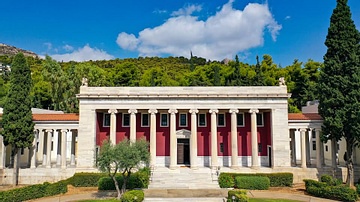Search Images
Browse Content (p. 686)

Image
American School of Classical Studies, Athens
Aerial Shot of the American School of Classical Studies in Athens

Image
The American School of Classical Studies in Athens
Aerial Shot of the American School of Classical Studies in Athens.

Image
The Blegen Library
The Blegen Library in Athens.

Image
16th Century CE Flemish Book Printer
An illustration of a Flemish printer's shop, Impressio Librorum. Made in Antwerp, 1580-1605 CE. (British Museum, London)

Image
Early-modern Bookwheel
An early-modern bookwheel, used to display several open books at once. (Jagiellonian University Museum Krakow, Poland)

Image
Juvenal's Satires
Engraved title page to Robert Stapylton's translation of 'Juvenalls Satyrs' with a portrait of Juvenal (l. c. 55-138 CE) in the centre.
Print made by Thomas Rawlins, 1645-1670 CE.

Image
Juvenal
Statue of Junius Juvenal on a pedestal lettered with his name, holding a scroll. Frontispiece to Robert Stapylton's Mores Hominum. The Manners of Men, Described in Sixteen Satyrs by Juvenal (London: 1660 CE). Etching after Robert Streeter...

Image
Mayflower Compact, Pilgrim Monument
Text of the "Mayflower Compact" inscribed at the base of the Pilgrim Monument, Provincetown, MA

Image
Giovanni Boccaccio, Uffizi
A statue of the Italian poet and scholar Giovanni Boccaccio (1313-1375 CE). Created in the 19th century CE by Odoardo Fantacchiotti. (Uffizi Gallery, Florence).

Image
William Bradford
Statue of William Bradford (l. 1590-1657 CE), Mayflower passenger and the second governor of the Plymouth Colony after the death of John Carver. Bradford's Of Plymouth Plantation provides a first-hand account of the voyage and the establishment...